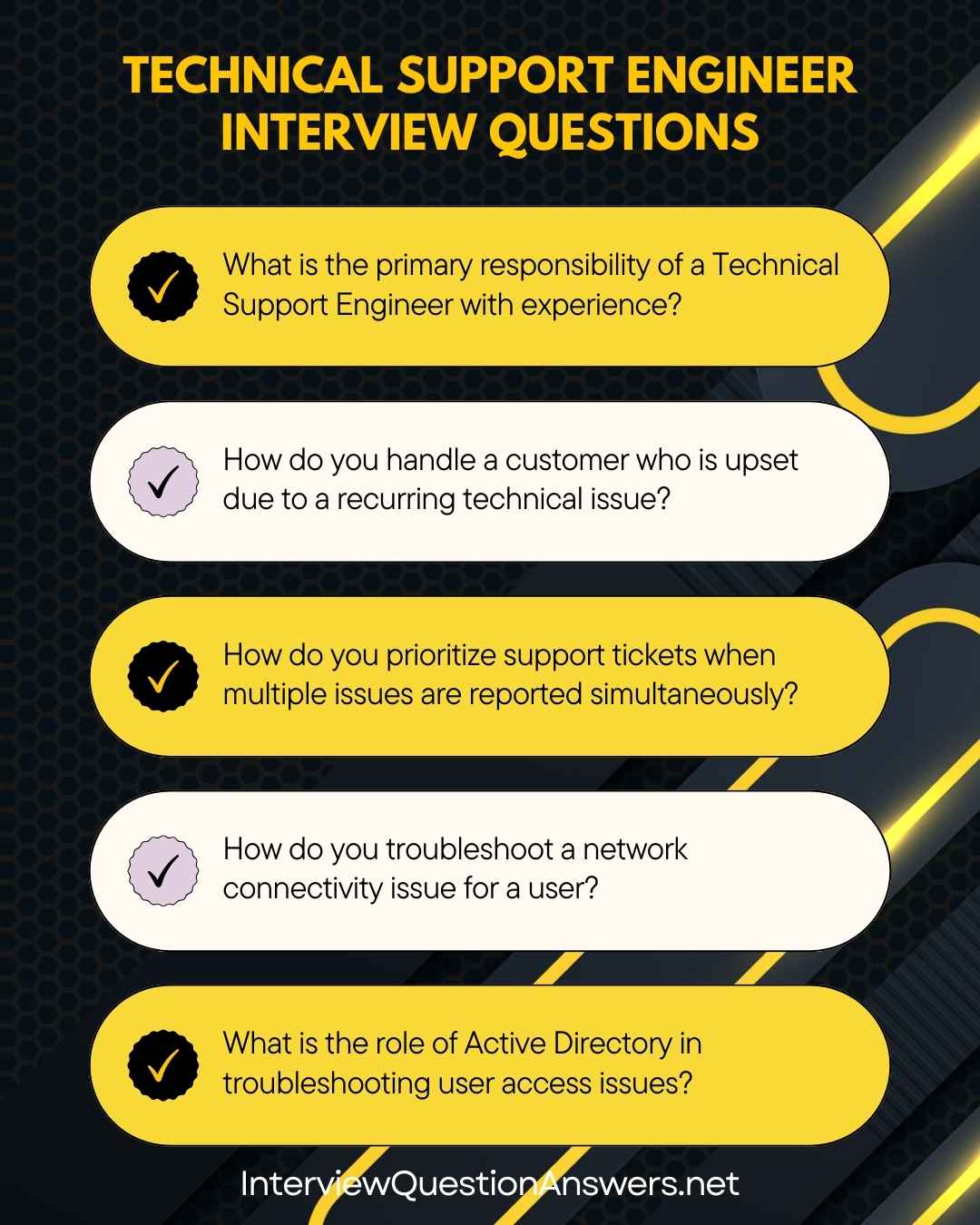Technical Support Engineer Interview Questions for Experienced
This Technical Support Engineer Interview Questions for Experienced guide provides a comprehensive set of advanced and scenario-based questions designed to help you showcase your technical expertise, troubleshooting skills, and problem-solving capabilities.
With organizations increasingly relying on hybrid IT environments, SaaS applications, and cloud infrastructure, experienced technical support engineers need a strong grasp of monitoring tools, ITIL processes, cybersecurity practices, and incident management frameworks.
This guide helps you master key technical support concepts such as network troubleshooting, system administration, cloud support, database management, ticketing tools, and automation scripts. It also covers server outages, application performance issues, security incidents, and remote user support, allowing you to prepare for the kinds of challenges companies expect experienced professionals to handle.
You can also check this detailed guide: Technical Support Engineer Interview Questions PDF
Table of Contents
Technical Support Engineer Interview Questions for 2 Years Experience
Que 1. What is the primary responsibility of a Technical Support Engineer with experience?
Answer:
A Technical Support Engineer resolves technical issues for customers or internal teams, troubleshoots hardware/software problems, and ensures timely resolution while maintaining clear communication. They also document issues and contribute to process improvements.
Que 2. How do you handle a customer who is upset due to a recurring technical issue?
Answer:
Listen empathetically, acknowledge their frustration, and gather details about the issue. Reproduce the problem, check logs, and apply a solution or escalate if needed. Follow up to ensure resolution and document for future reference.
Que 3. How do you prioritize support tickets when multiple issues are reported simultaneously?
Answer:
Prioritize based on severity (e.g., system outages), impact (e.g., number of users affected), and SLA requirements. Use a ticketing system like Jira or ServiceNow to track and manage tickets efficiently.
Que 4. How do you troubleshoot a network connectivity issue for a user?
Answer:
Verify physical connections, check IP configuration with ipconfig, and ping the gateway or external sites (e.g., 8.8.8.8). Use tracert to identify bottlenecks and check firewall settings.
# Check IP configuration (Windows)
ipconfig /allQue 5. What is the role of Active Directory in troubleshooting user access issues?
Answer:
Active Directory manages user accounts and permissions. Troubleshoot by checking account status, group policies, or resetting passwords using tools like PowerShell or dsquery.
# Check user account status
Get-ADUser -Identity usernameQue 6. How do you troubleshoot a computer that fails to boot?
Answer:
Check power connections, verify hardware (e.g., RAM, hard drive), and test in Safe Mode. Review BIOS settings, use diagnostic tools, or restore from a backup if necessary.
Que 7. What is a DNS issue, and how do you resolve it?
Answer:
A DNS issue prevents domain name resolution. Resolve by flushing the DNS cache, changing DNS servers (e.g., to 8.8.8.8), or verifying DNS server connectivity.
# Flush DNS cache (Windows)
ipconfig /flushdnsQue 8. How do you troubleshoot a slow-performing application?
Answer:
Check system resources (CPU, memory) using Task Manager, review application logs for errors, and ensure software is updated. Clear cache, optimize settings, or reinstall the application.
# Check resource usage (Windows)
taskmgrQue 9. What is the purpose of a ticketing system in technical support?
Answer:
A ticketing system (e.g., Zendesk, Freshdesk) organizes support requests, tracks resolution progress, and maintains a history of issues. It improves efficiency and ensures accountability.
Que 10. How do you use log files to diagnose technical issues?
Answer:
Analyze logs (e.g., Windows Event Viewer, /var/log) to identify error codes or patterns. Correlate timestamps with user-reported issues and use tools like Splunk for advanced analysis.
# View Linux logs
tail -f /var/log/syslog
Also Check: Technical Support Engineer Interview Questions for Freshers
Technical Support Engineer Interview Questions for 3 Years Experience
Que 11. How do you troubleshoot a printer not responding?
Answer:
Verify connections, ensure the printer is online, and check drivers. Clear the print queue, restart the spooler service, and test with another device or port.
# Restart print spooler (Windows)
net stop spooler && net start spoolerQue 12. What is the difference between TCP and UDP, and how does it impact troubleshooting?
Answer:
TCP is reliable and connection-oriented (e.g., for web traffic), while UDP is faster but less reliable (e.g., for streaming). Troubleshoot TCP issues with netstat to check connections, and UDP issues with packet sniffers like Wireshark.
# Check TCP connections
netstat -anQue 13. How do you troubleshoot a VPN connection failure?
Answer:
Verify credentials, check VPN client settings, and test server connectivity with ping. Ensure firewall rules allow VPN traffic and review logs for errors.
# Test VPN server
ping vpn.example.comQue 14. How do you ensure data privacy when providing technical support?
Answer:
Use secure tools (e.g., encrypted RDP), avoid storing sensitive data, and follow company policies or regulations like GDPR. Document actions in a ticketing system for transparency.
Que 15. How do you troubleshoot a blue screen error on a Windows system?
Answer:
Note the error code, check Event Viewer for logs, and update drivers. Scan for malware, boot in Safe Mode, or use System Restore to recover the system.
# Open Event Viewer
eventvwrQue 16. What is a Service Level Agreement (SLA), and how does it guide your work?
Answer:
An SLA defines response and resolution times for support issues. It guides prioritization, ensures timely responses, and aligns with customer expectations for service quality.
Que 17. How do you troubleshoot an email delivery failure?
Answer:
Verify SMTP/IMAP settings, check spam filters, and test server connectivity with telnet. Ensure correct credentials and review DNS records (e.g., MX) for misconfigurations.
# Test email server
telnet smtp.example.com 587Que 18. How do you use remote desktop tools to assist users?
Answer:
Use tools like TeamViewer or Microsoft Remote Desktop to access a user’s system securely. Verify permissions, guide the user through setup, and troubleshoot issues while maintaining privacy.
# Start Remote Desktop (Windows)
mstscQue 19. What is the role of a firewall in troubleshooting network issues?
Answer:
A firewall controls network traffic and may block connections. Check rules to ensure ports (e.g., 80, 443) are open and test with telnet or netstat to diagnose blocks.
# Check open ports
netstat -an | findstr 443Que 20. How do you troubleshoot a software update failure?
Answer:
Verify internet connectivity, check disk space, and ensure user permissions. Clear update cache, restart services, or manually download updates to resolve the issue.
# Clear Windows Update cache
net stop wuauserv && del /q /f "%windir%\SoftwareDistribution\*"Technical Support Engineer Interview Questions for 5 Years Experience
Que 21. How do you troubleshoot a cloud-based application issue (e.g., hosted on AWS)?
Answer:
Check AWS CloudWatch logs for errors, verify EC2 instance or Lambda status, and ensure IAM permissions are correct. Test connectivity to services like S3 or RDS.
# Check CloudWatch logs
aws logs tail /aws/lambda/my-functionQue 22. How do you escalate a complex issue to a higher support tier?
Answer:
Document the issue, steps taken, and logs in the ticketing system. Provide a clear summary, including error codes and impact, and communicate with the customer about the escalation process.
Que 23. How do you troubleshoot a Group Policy issue in Active Directory?
Answer:
Use gpresult to verify applied policies, check Event Viewer for errors, and force updates with gpupdate. Ensure the client is domain-connected and permissions are correct.
# Force Group Policy update
gpupdate /forceQue 24. How do you troubleshoot a server that is running slowly?
Answer:
Check resource usage (CPU, memory, disk) with top or Task Manager, review logs for errors, and optimize services. Restart unnecessary processes or escalate to system admins.
# Check resource usage (Linux)
topQue 25. How do you use scripting to automate technical support tasks?
Answer:
Use PowerShell or Bash to automate tasks like log analysis or user account management. For example, a script can reset passwords or clear temp files across systems.
# PowerShell to clear temp files
Get-ChildItem -Path $env:TEMP -Recurse | Remove-Item -ForceQue 26. How do you troubleshoot a database connection failure?
Answer:
Verify credentials, test connectivity with telnet, and check firewall rules. Review database logs (e.g., MySQL) and ensure the service is running.
# Test database connection
telnet db.example.com 3306Que 27. How do you maintain a knowledge base for technical support?
Answer:
Document common issues, solutions, and error codes in a knowledge base (e.g., Confluence). Update regularly with new resolutions and share with the team to improve efficiency.
Que 28. How do you troubleshoot a web application not loading?
Answer:
Check browser console for errors, verify server status, and test connectivity. Clear cache, check DNS resolution, and review server logs (e.g., Nginx, Apache) for issues.
# Check Nginx logs
tail -f /var/log/nginx/error.logQue 29. How do you ensure compliance with IT security policies during support?
Answer:
Use secure tools (e.g., SSH, RDP), avoid storing sensitive data, and follow policies like GDPR or HIPAA. Log all actions in a ticketing system for audit purposes.
Que 30. How do you handle intermittent application performance issues reported by a user?
Answer:
Reproduce the issue, check application logs, and monitor resource usage with tools like CloudWatch or New Relic. Identify patterns, optimize configurations, or escalate to developers if needed.
# Check CloudWatch metrics
aws cloudwatch get-metric-statistics --metric-name CPUUtilization --namespace AWS/EC2Technical Support Engineer Interview Questions for 8 Years Experience
Que 31. How do you troubleshoot complex performance issues in a cloud-based application?
Answer:
Analyze metrics using AWS CloudWatch or Azure Application Insights to identify bottlenecks (e.g., high CPU, latency). Check logs, optimize resource allocation (e.g., EC2, Lambda), and use distributed tracing with AWS X-Ray. Implement caching (e.g., ElastiCache) and escalate to developers if needed.
# Check CloudWatch metrics for performance
aws cloudwatch get-metric-statistics --metric-name CPUUtilization --namespace AWS/EC2 --period 300Que 32. How do you handle a critical system outage affecting multiple enterprise clients?
Answer:
Prioritize the issue, gather details from logs (e.g., CloudWatch, ELK Stack), and verify infrastructure status (e.g., EC2, RDS). Coordinate with teams, communicate updates via SLAs, and implement failover or recovery plans. Document root cause analysis (RCA) post-resolution.
# Check RDS status
aws rds describe-db-instances --db-instance-identifier mydbQue 33. How do you troubleshoot intermittent connectivity issues in a hybrid cloud environment?
Answer:
Verify connectivity via AWS Direct Connect or Azure ExpressRoute, check VPN configurations, and analyze network logs with Wireshark or CloudTrail. Test latency with ping or traceroute, and ensure firewall rules and VPC peering are correctly configured.
# Test connectivity to hybrid cloud
ping onprem.example.comQue 34. How do you optimize a technical support process for a large-scale environment?
Answer:
Implement automation with scripts (e.g., PowerShell, Bash) for repetitive tasks, use AI-driven ticketing systems (e.g., ServiceNow), and maintain a robust knowledge base. Monitor KPIs like resolution time and train teams on best practices.
# Automate user account checks
Get-ADUser -Filter * | Where-Object { $_.Enabled -eq $false } | Export-Csv disabled_users.csvQue 35. How do you troubleshoot a Group Policy issue affecting multiple users?
Answer:
Use gpresult /r to verify applied policies, check Event Viewer for GPO errors, and ensure domain controller connectivity. Force updates with gpupdate /force, validate permissions, and review policies in Active Directory.
# Force Group Policy update
gpupdate /forceQue 36. How do you ensure compliance with security standards like GDPR or HIPAA during support?
Answer:
Use encrypted tools (e.g., SSH, RDP), avoid storing sensitive data, and log actions in a ticketing system. Implement access controls with IAM or Active Directory and audit with tools like AWS CloudTrail to ensure compliance.
# Check CloudTrail logs
aws cloudtrail lookup-events --lookup-attributes AttributeKey=EventName,AttributeValue=ConsoleLoginQue 37. How do you troubleshoot a database performance issue in a cloud environment?
Answer:
Monitor metrics with CloudWatch (RDS) or Azure Monitor (SQL Database), check slow query logs, and optimize indexes. Scale resources (e.g., increase IOPS), enable caching (e.g., ElastiCache), and review connection pools.
# Check RDS performance metrics
aws cloudwatch get-metric-statistics --metric-name DatabaseConnections --namespace AWS/RDSQue 38. How do you handle a security incident, such as unauthorized access to a system?
Answer:
Isolate the affected system, revoke compromised credentials, and analyze logs with CloudTrail or Splunk. Apply patches, enable MFA, and conduct an RCA to prevent recurrence. Communicate with stakeholders per incident response protocols.
# Check for unauthorized access in CloudTrail
aws cloudtrail lookup-events --lookup-attributes AttributeKey=EventName,AttributeValue=UnauthorizedAccessQue 39. How do you troubleshoot a cloud-based API failure?
Answer:
Check API Gateway logs (e.g., AWS CloudWatch), verify IAM permissions, and test endpoints with tools like Postman. Ensure backend services (e.g., Lambda, EC2) are operational and review rate limits or CORS settings.
# Check API Gateway logs
aws logs filter-log-events --log-group-name /aws/apigateway/my-apiQue 40. How do you implement automation to reduce ticket resolution time?
Answer:
Use PowerShell, Bash, or Python scripts to automate tasks like log analysis, user provisioning, or system checks. Integrate with ticketing systems (e.g., ServiceNow) and use chatbots for common queries.
# Python script to check server status
import boto3
ec2 = boto3.client('ec2')
response = ec2.describe_instances()
for instance in response['Reservations'][0]['Instances']:
print(f"Instance {instance['InstanceId']} is {instance['State']['Name']}")Technical Support Engineer Interview Questions for 10 Years Experience
Que 41. How do you troubleshoot a containerized application issue (e.g., Docker on AWS ECS)?
Answer:
Check ECS task logs in CloudWatch, verify container health, and ensure IAM roles and networking (VPC, security groups) are correct. Restart tasks or scale the service if needed.
# Check ECS task logs
aws logs filter-log-events --log-group-name /ecs/my-taskQue 42. How do you manage and resolve recurring technical issues in a support environment?
Answer:
Conduct RCAs to identify root causes, update the knowledge base, and implement preventive measures like patches or configuration changes. Train teams and automate checks to reduce recurrence.
Que 43. How do you troubleshoot a virtual machine failure in a cloud environment?
Answer:
Check VM status (e.g., AWS EC2, Azure VM), review CloudWatch metrics, and analyze logs for errors. Verify security groups, reboot the instance, or restore from a snapshot if needed.
# Check EC2 instance status
aws ec2 describe-instances --instance-ids i-1234567890abcdef0Que 44. How do you handle a situation where a critical application is down during off-hours?
Answer:
Follow the incident response plan, access monitoring tools (e.g., CloudWatch, Nagios), and troubleshoot using logs or diagnostics. Notify stakeholders, escalate to on-call teams, and document the resolution.
Que 45. How do you troubleshoot a performance issue in a web server (e.g., Apache, Nginx)?
Answer:
Check server logs (e.g., /var/log/nginx/error.log), monitor resource usage with top, and optimize configurations (e.g., caching, compression). Use tools like New Relic to analyze performance.
# Check Nginx error logs
tail -f /var/log/nginx/error.logQue 46. How do you ensure effective collaboration with development teams during issue resolution?
Answer:
Share detailed logs, error codes, and RCAs via ticketing systems (e.g., Jira). Communicate clearly, provide reproducible steps, and participate in post-mortems to align on fixes.
Que 47. How do you troubleshoot a backup failure in a cloud environment?
Answer:
Check backup service logs (e.g., AWS Backup, Azure Backup), verify permissions, and ensure storage availability. Test restore processes and update backup schedules if needed.
# Check AWS Backup status
aws backup list-backup-jobsQue 48. How do you use monitoring tools to proactively prevent issues?
Answer:
Set up alerts with CloudWatch or Zabbix for thresholds (e.g., CPU > 80%). Monitor trends with dashboards, automate health checks, and address potential issues before they impact users.
# Set CloudWatch alarm
aws cloudwatch put-metric-alarm --alarm-name HighCPU --metric-name CPUUtilization --threshold 80Que 49. How do you troubleshoot a multi-region cloud application failure?
Answer:
Verify region-specific resources (e.g., EC2, RDS) with CloudWatch, check Route 53 routing policies, and analyze cross-region replication (e.g., S3 CRR). Fail over to a secondary region if needed.
# Check Route 53 health
aws route53 list-health-checksQue 50. How do you mentor junior support engineers to improve team efficiency?
Answer:
Share best practices, conduct training on tools (e.g., CloudWatch, Wireshark), and guide them through complex issues. Encourage documentation and knowledge-sharing to build team expertise.
Conclusion
We have already shared the questions for Technical Support Engineer Interview Questions for Experienced, covering advanced troubleshooting topics, system-level problem-solving questions to help you prepare thoroughly. This Technical Support Engineer Interview Questions for Experienced Guide ensures you gain the confidence to answer complex questions and demonstrate your technical expertise effectively.
Similar Guides:













